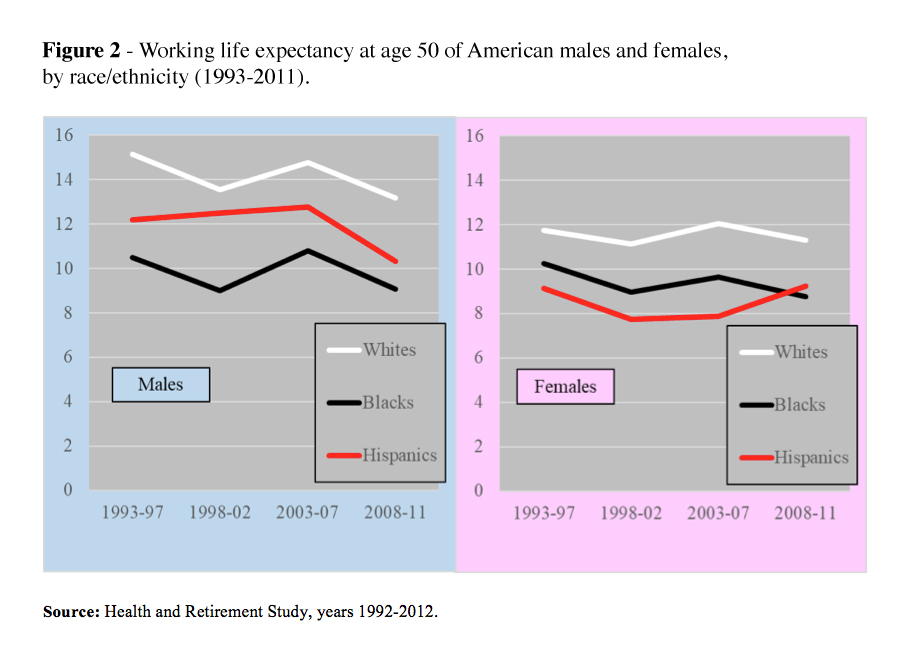Christian Dudel and Mikko Myrskylä study how the length of working life has developed in the U.S. since the early 1990s. While overall life expectancy has increased, there has been no expansion of working life. Recessions and financial crises have a negative impact on working life expectancy, with considerable heterogeneity by gender and race.
Life expectancy has been steadily increasing in high-income countries. At the same time, fertility is around or below the replacement level. Consequently, populations are rapidly aging. In the U.S., the share of the population aged 65 and older is projected to increase from 15% in 2014 to 24% in 2060 (Colby and Ortman 2015).
Population aging casts doubt on the long-term sustainability of social security systems, because as the population grows older, the share of economically active population shrinks. To encourage individuals to stay in the labor market longer and to increase the average length of working life, policies such as increasing retirement age are being implemented. In the U.S., for instance, the Social Security retirement age has been raised from age 65 to 66 for individuals born in 1943 to 1954, and it will increase further for individuals born in 1955 and in later years.
Despite its crucial importance for the sustainability of social security systems, little is known about the length of working life. In a recent paper (Dudel and Myrskylä 2017), we use longitudinal data of the U.S. Health and Retirement Study and multistate models to find out more about the length of working life – which we call working life expectancy – and the factors that shape it, like gender and education. We focus on the effects of the recent financial crisis, as well as on gender and racial differences.
Older Americans and the financial crisis
In Figure 1, trends in the length of working life by gender are shown covering four periods: from 1993 to 1997; from 1998 to 2002; from 2003 to 2007; and from 2008 to 2011. Our results, which are based on a period perspective, show how long people would work if the economic conditions of a certain period, such as 1993-1997, prevailed over their entire working lives.
Based on the economic conditions of the 2008-2011 period, the working life expectancy at age 50 would be around 13 years for American men and 11 years for American women. In relative terms, men would spend more than two-fifths of their remaining lifetime working, and women one-third.
When we compare the results for 2008-2011 with those of earlier periods, we find that working life expectancy during this period is close to that of the 2001 recession (1998-2002); the financial crisis lowered working life expectancy by 1-2 years. It appears that these adverse labor market conditions had a greater effect than incentives to stay in the labor market. This effect was smaller for women than for men, in part because more men than women were working in the industries most affected by the crisis.
While working life expectancy saw ups and down during the period under study, the remaining life expectancy at age 50 steadily increased (Figure 1). This means that the proportion of life expectancy spent working past age 50 declined over time, albeit irregularly.
Strong differentials by race/ethnicity
Our findings also show that there is considerable heterogeneity across sub-populations. These differences can be seen in Figure 2, which shows the length of working life by gender and race/ethnicity.
The working life expectancy of black males at age 50 is consistently between four to five years lower than that of non-Hispanic white males, and this gap has been only slightly affected by the recent crisis. These results, of course, are also influenced by differences between the groups in education, occupation, etc. However, even accounting for these differences – between blacks and whites, for instance – the gap in the length of the working life persists, though at a lower level, suggesting that other variables are operating, e.g., the relative disadvantages of, and discrimination against, blacks in the labor market (Altonji and Blank 1999; Pager 2009).
The 2007-2008 crisis had the strongest negative impact on male Hispanics, who lost more than two years of working life expectancy between 2003-2007 and 2008-2011. In contrast, Hispanic females actually experienced a notable increase in the 2008-2011 period, of around one year. One explanation for this finding is that labor force participation of female Hispanics was relatively low before the crisis, so there was considerable potential for the so-called “added worker” effect: i.e., for inactive individuals who were not in the labor force, such as homemakers, to enter the labor market when their partner became unemployed.
How do Americans compare to the rest of the world?
While there is considerable variation in the length of working life in the U.S. by race/ethnicity, even the subpopulations with low working life expectancy tend to have a longer average working life than people in other high-income countries for which data are available, including in the UK (Butt et al. 2008), Spain (Dudel et al. 2018), and Finland (Leinonen et al. 2016).
For instance, in 2012 in Finland, men aged 50 could expect to work for another nine years (Leinonen et al. 2016), or roughly one-third of their remaining life expectancy. Non-Hispanic white, black, and Hispanic males in the U.S. in the 2008-2011 period all had a remaining working life expectancy of between nine and 13 years, i.e. at least two-fifths of remaining life expectancy. The results for U.S. women by race/ethnicity are all close to the Finnish average of 10 years.
Conclusions
Our results show that there has been no overall expansion of the length of working life, partly due to the recent crisis, which has led to a decline in working life expectancy. The differences in working life expectancy across subpopulations are substantial, with gender, race/ethnicity, and the intersection of these factors playing important roles. This heterogeneity is a cause for concern, as the working life expectancy of some groups, and particularly of blacks, is markedly lower than it is for others. Policies aimed at increasing the length of working life should better address this heterogeneity.
References
Altonji, J. G. and Blank, R. M. (1999). Race and gender in the labor market. In Ashenfelter, O. C. and Card, D., editors, Handbook of Labor Economics, pages 3143–3259. Elsevier.
Butt, Z., Haberman, S., and Verral, R. (2008). Calculating compensation for loss of future earnings: Estimating and using working life expectancy. Journal of the Royal Statistical Society, Series A 171: 763–805.
Colby, S. L. and Ortman, J. M. (2015). Projections of the size and composition of the U.S. population: 2014 to 2060. Washington, D.C.: U.S. Census Bureau.
Dudel, C., Myrskylä, M. (2017): Working Life Expectancy at Age 50 in the US and the Impact of the Great Recession. Demography 54: 2101-2123.
Dudel, C., López Gómez, M. A., Benavides, F. G., Myrskylä, M. (2018): The Length of Working Life in Spain Levels, Recent Trends, and the Impact of the Financial Crisis. European Journal of Population: forthcoming (available online).
Engemann, K. M. and Wall, H. J. (2009). The effects of recessions across demographic groups. Federal Reserve Bank of St. Louis Working Paper 2009-052A.
Leinonen, T., Martikainen, P., and Myrskylä, M. (2016). Life expectancy by labor force status and social class: Recent period and cohort trends and projections for Finland. Journal of Gerontology, Series B: Psychological Sciences and Social Sciences: Advance access.
Pager, D. (2009). Discrimination in a low-wage labor market. A field experiment. American Sociological Review 74:777–799.




